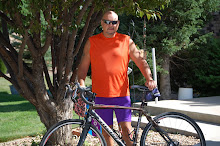Hopefully you have got in at least three rides by now, how do you feel? If it feels harder each ride, take two days off then back to every other day. If you are feeling good and you are attempting to get faster every ride attempt an everyday ride and work on getting your average cadence up two or three “RPM’s” (revolutions a Minute). During most of my rides this past week I was thinking how this training regiment has worked for me and has it really worked. About that time I was going up, roughly, a three hundred yard incline that I used to hate coming to and actually had to walk up the last ten to fifteen yards. I looked down at my odometer and was going up the incline at eighteen mph and crested the top at fourteen mph. I guess my question was answered.
I really wished I had listened to people way earlier in my bicycling adventures and started a training log much earlier. I was struggling this time last year and this month my rides are averaging 18.9 mph at 12.9 with a 70 rpm cadence. I just turned 61. I didn’t start my log till August of 2008. A training log will give you an enormous burst of enthusiasm, build your confidence and most importantly give you constant positive feed back. A training log is a piece of paper, a computer word document you design, a program that came with your really fancy odometer (a Garmin is outstanding, I will have one some day) or a pre-made on line system (http://traininglog.bicycling.com/landingpage.aspx) is outstanding.
I use a page of six column ledger paper. Laid out like below;
Date Route Time and Ave. Temp Miles Elapsed Time Ave. Speed Max Speed Ave./Max Cadence
I also have little symbols for wind and flat tires. I also try to scribble notes for something that was special, easy or difficult on the ride. It appears I have received a twelve column ledger which will be much easier and less cramped to make notes. I also am going to take a closer look at Bicycling Magazine’s log set up, it looks really good. At the end of each month I total all the columns and average the numbers. I also keep a running total of my mileage and mark if I have improved or lost from the prior month.
I feel the routes are important for overall averages. I have about five routes some I can combine while in route others I need to pack the bike and junk and drive for a bit. Due to this I have a fairly flat route that I can ride any distance my butt will last. This flat route usually has a higher average speed to it and it is not reasonable to compare those trips with a rolling route.
Time and Average Temperature may not seem much but they are. I have found that I ride much faster when it is above seventy degrees and even faster if it is that warm around nine in the morning rather than at noonish.
The rest is pretty self explainable and the more notes you can add the better. You will learn to use your information to work for you and throw in a little weight training (no need to buy equipment use canned veggies or the new large coffee cans and liquid bottles with the cool handles). This will start moving your metabolism and tighten the places that use to be fat.
Do and Don’ts; When you are coming to a stop, shift to an easier pedaling gear. This will make starting up again much easier. While we are speaking of shifting here is a trick courtesy of Steve at Bike Source. Make your shift when your RIGHT foot is level with the ground and behind (the nine o’clock position). Your shifts will be very smooth and exact, you can even get by with an up hill down shift which is a real taboo. On the don’t side I will take a page from my own book of stupidity. If you are going to ride a mountain pass area, road or mountain, and you are wearing a hydration backpack make sure it is not filled with an adult beverage. My pass which required a long decent to get back, Vail Pass, Vail to the summit and back to the village.
Practice, Practice, Practice
Next post encounters with varmints and reptiles.
“G”
Tuesday, May 12, 2009
Subscribe to:
Post Comments (Atom)

No comments:
Post a Comment